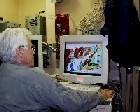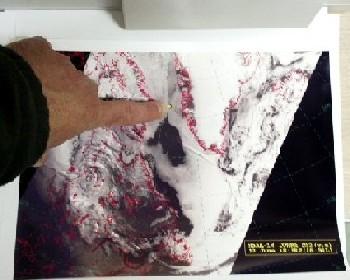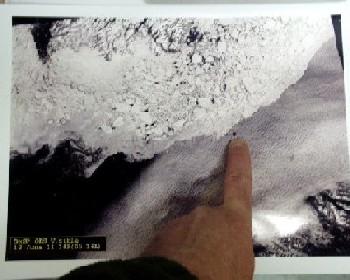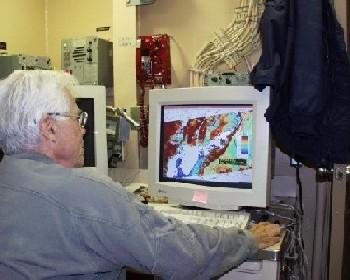11 June, 2000
Ice; From a Bird's Eye Point of View
At 9 A.M., the USCGC Healy left Nuuk, Greenland and headed out to open
water. The beginning of our cruise was beautiful with clear skies and blue
water. Unfortunately, our luck did not last too long. We soon were
enveloped in a shroud of fog. On the bridge, careful attention was paid to
the location of other marine traffic as we made our way to sea. So where
in the world are we going and how will we know just where to go? The
answers to those questions are the focus of my journal entry for today.
The Healy is to have its propulsion system checked again, so we need to
reach ice flows that will put up enough resistance to satisfy the demands
required. To find such an ice flow, the Healy utilizes meteorological
satellite imaging software known as Tera Scan. I spoke with Bob Whritner to
learn about one of the uses of the software, identifying ice flows.
Bob Whritner is a manager with the Arctic and Antarctic Research Center at
Scripps Institution of Oceanography. Bob trains members of the Coast Guard
on the use of the Tera Scan software. He has been invited on this leg of
the ice trials to help crewmembers develop their skills in using and
interpreting data received from the microwave sensors on NOAA and military
satellites.
During this cruise three basic types of satellite images will be
analyzed; visible spectrum, infrared, and microwave. The visible spectrum
images are just what you would expect them to be. They are actual camera
images that need little enhancement. During cloud free weather, you cannot
get any better information. The second type of image is the infrared image.
Infrared imaging uses the differences in the temperatures of objects to form
an image. In a polar climate where temperatures of water and ice tend to
vary little, this type of imagery is not very practical in locating ice.
Also one needs clear weather to get a detailed image of the surface of the
water, infrared cannot "see" through clouds. Infrared imaging is most
useful with weather data collection and forecasting. The third type of image
uses information gathered from microwaves that are emitted from the water
and ice to the satellites. This information is much more detailed and takes
more expertise to interpret the data correctly. Microwave data can be used
to determine the percent concentration of an ice flow. It can also help
determine whether the ice flow is made up of first year or multi-year ice,
based on the type of microwaves emitted. Microwave data can even give an
indication of wind speed, based on the features of the surface of the water.
All of this information can be gathered, whether the skies are clear or
cloudy. Microwave data is not dependent on weather conditions.
Based on the images below, we set sail to the East coast of Nunavut to find
the ice needed for the propulsion testing. More information about
meteorological data collection will follow in a future journal entry.
Todd

Bob looks over the microwave imagery for the morning of 06/11/00.

If you look closely on this visible spectrum image, the black dot at my finger tip is the ship's location. We are located between Greenland and Nunavut.

This visible spectrum image shows the ship's position between Nunavut, to the left, and Greenland to the right.

This visible spectrum image clearly shows the ice flow to the left. At the tip of my finger, the black dot represents the ship's position.

Bob Whritner of Scripps Institution of Oceanography.

Bob examines an image produced from microwave data to determine where the best ice is.
Contact the TEA in the field at
.
If you cannot connect through your browser, copy the
TEA's e-mail address in the "To:" line of
your favorite e-mail package.
|
